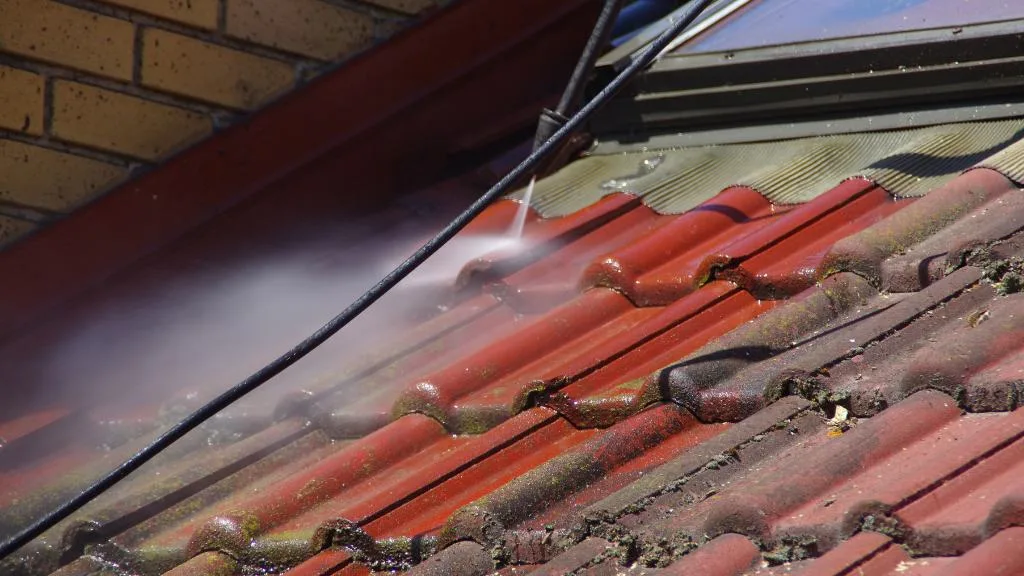
Soft wash roof cleaning is a highly effective and safe method of removing algae, moss, and other debris from your roof. Unlike traditional pressure washing, soft washing uses low-pressure water and specialized cleaning solutions to gently clean and restore your roof without causing any damage.
In this comprehensive guide, we’ll explore everything you need to know about soft wash roof cleaning, including how it works, the benefits of this method, and how to choose a reliable and experienced professional for the job.
What is Soft Wash Roof Cleaning?
If you’re looking for an effective and eco-friendly way to clean your roof, soft wash roof cleaning might be the solution you need. Soft wash roof cleaning is a cleaning method that uses a low-pressure washing technique to clean dirt from roofs and remove unwanted growths such as algae, moss, mildew, and lichen.
Unlike high-pressure water cleaning, soft wash roof cleaning uses a soft wash system that is gentle on your roof and doesn’t damage the shingles.
Soft wash roof cleaning is achieved by using a specially designed pressure spray nozzle to apply a solution of detergent and water to the roof at low pressure. The chemical solution is left to sit on the roof for a short period, usually around 15 minutes, to allow it to break down dirt and other growths.
Afterward, the roof is rinsed with fresh water to remove the solution and any dirt and growths that have been broken down.
One of the benefits of soft wash roof cleaning is that it uses 90% less water than high-pressure washing, making it a more eco-friendly option. Additionally, soft wash roof cleaning is a chemical-based cleaning method that doesn’t require the use of high-pressure water.
This means that it’s a safer option for cleaning roofs since it doesn’t damage the shingles or other roofing materials.
In summary, soft wash roof cleaning is an eco-friendly and gentle cleaning method that uses a low-pressure washing technique and a chemical solution to clean dirt from roofs and remove unwanted growths.
It’s a safer and more effective option than high-pressure water cleaning since it doesn’t damage the shingles and requires less water.
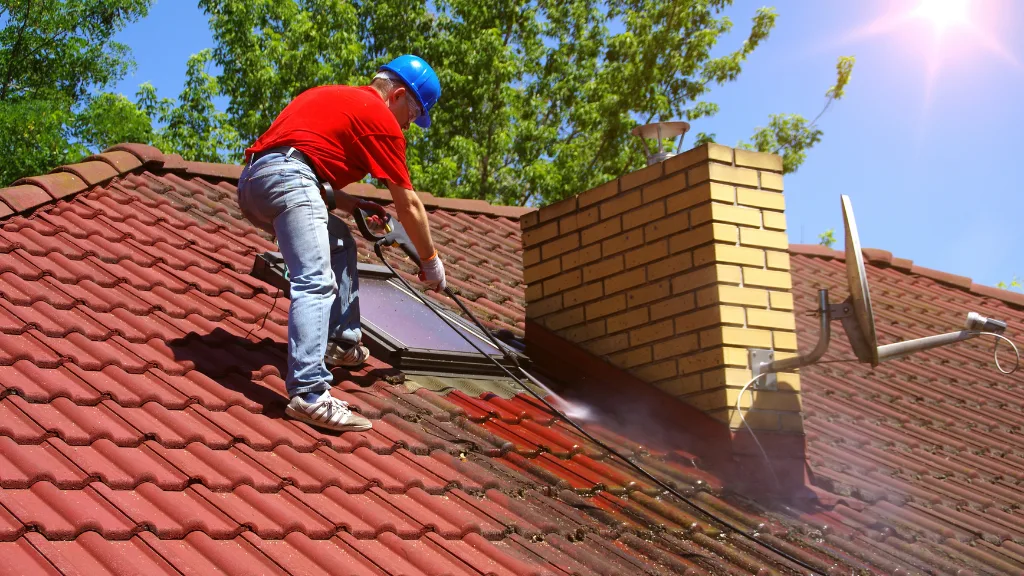
Why Soft Wash Roof Cleaning is Important
Your roof is an essential part of your home’s structure, and it is essential to keep it clean and well-maintained. Soft wash roof cleaning is an effective way to remove dirt, algae, moss, and other living organisms that can damage your roof and reduce its lifespan.
Here are some reasons why soft wash roof cleaning is important:
Prevents Damage
Mold, algae, and moss can grow on your roof, and they can cause damage to the shingles, tiles, or metal panels. If left untreated, these organisms can eat away at the roofing material and cause leaks, rot, and other problems.
Soft wash roof cleaning removes these contaminants and helps prevent damage to your roof.
Improves Appearance
Dirt, black streaks, and other stains can make your roof look old and worn out. Soft wash roof cleaning can improve the appearance of your roof and make it look new again.
It can also boost your home’s curb appeal and increase its value.
Protects Your Health
Mold and mildew can cause respiratory problems and other health issues. Soft wash roof cleaning can remove these contaminants and protect your health.
It can also prevent the growth of bacteria and other harmful organisms that can cause odors and other problems.
Environmentally Friendly
Soft wash roof cleaning is a biodegradable and environmentally-friendly method of cleaning your roof. It uses low-pressure water and eco-friendly cleaning solutions to remove contaminants without harming the environment.
It is an excellent alternative to harsh chemicals and acids that can damage your roof and harm the environment.
Long-Lasting Results
Soft wash roof cleaning provides long-lasting results that can prevent the growth of mold, algae, and other contaminants for several years. It can also prevent the growth of moss and lichen that can damage your roof and reduce its lifespan.
Additionally, soft wash roof cleaning can include moss prevention treatment and plant protectors to keep your roof looking great for years to come.
In conclusion, soft wash roof cleaning is an effective and environmentally-friendly way to keep your roof clean and well-maintained. It can prevent damage, improve appearance, protect your health, and provide long-lasting results.
If you want to keep your roof in top condition, consider hiring a professional soft wash roof cleaning service today.
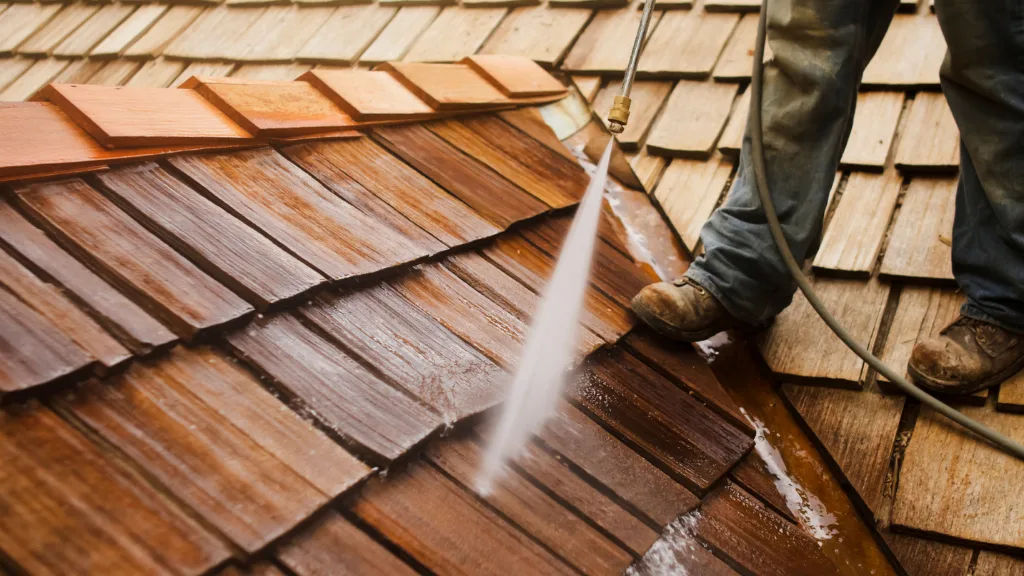
The Soft Wash Process
Soft washing is a process that uses low-pressure water and special cleaning solutions to remove dirt, algae, and other debris from your roof. This method is a safer and more effective way to clean your roof compared to traditional high-pressure washing.
Here’s how the soft wash process works.
Equipment and Materials
Before you start the soft wash process, you need to gather the necessary equipment and materials. Here are the items you will need:
- Pressure washer
- Soft wash spray gun
- Chemical-resistant gloves
- Safety glasses
- Rubber boots
- Respirator mask
- Cleaning solution
- Water
Chemicals and Soaps
The cleaning solution used in the soft wash process typically contains a combination of surfactants, bleach, soaps, and other chemicals. These chemicals work together to break down and remove dirt and debris from your roof.
Some of the most common chemicals used in soft washing include caustic, sodium hydroxide, and biocides.
It’s important to note that not all chemicals are safe for all types of roofs. For example, using harsh chemicals like hydrochloric acid on a slate roof can cause damage.
Always consult with a professional before using any chemicals on your roof.
The Cleaning Procedure
Once you have gathered your equipment and materials, it’s time to start the soft wash process. Here’s what you need to do:
- Prepare the area around your home by covering plants and outdoor furniture with tarps or plastic sheeting.
- Put on your safety gear, including gloves, safety glasses, rubber boots, and a respirator mask.
- Mix the cleaning solution according to the manufacturer’s instructions.
- Apply the cleaning solution to your roof using the soft wash spray gun. Start at the top of your roof and work your way down, making sure to cover every inch of your roof.
- Let the cleaning solution sit on your roof for 10-15 minutes.
- Rinse your roof with water using the pressure washer. Start at the top of your roof and work your way down, making sure to rinse away all of the cleaning solution.
- Inspect your roof for any remaining dirt or debris. If necessary, repeat the soft wash process.
In addition to the soft wash process, some homeowners choose to install zinc strips on their roof to prevent the growth of algae and other debris. Vinegar can also be used as a natural cleaning solution for some types of roofs.
Overall, the soft wash process is a safe and effective way to clean your roof and improve the curb appeal of your home. Always consult with a professional before attempting to clean your roof on your own.
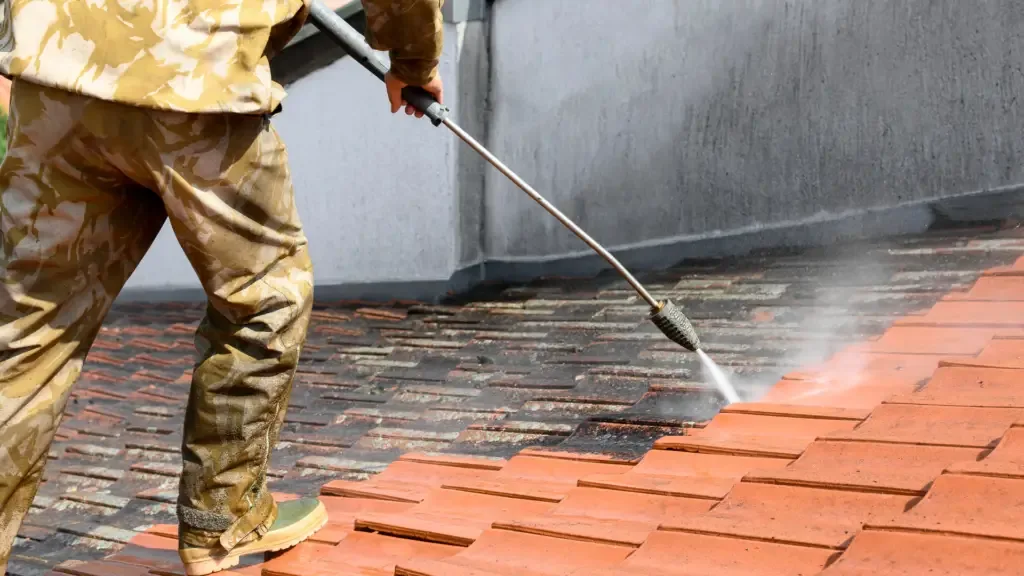
Soft Wash vs. Pressure Washing
When it comes to cleaning your roof, you have two options: soft washing and pressure washing. While both methods are effective at removing dirt, grime, and other debris, there are some key differences between the two.
Pressure Washing
Pressure washing, also known as high-pressure washing, uses a powerful stream of water to blast away dirt and grime. This method is great for cleaning hard surfaces like concrete, but it can be too harsh for delicate surfaces like your roof.
If you’re not careful, pressure washing can damage your roof’s shingles, leading to costly repairs. Additionally, pressure washing can force water underneath your shingles, leading to leaks and water damage.
Soft Washing
Soft washing, on the other hand, uses a low-pressure stream of water and specialized cleaning solutions to gently remove dirt and grime from your roof. This method is much safer for your roof and can actually extend the life of your shingles.
Soft washing is also more effective at removing organic growth like moss, algae, and lichen. These growths can be difficult to remove with pressure washing alone, but the specialized cleaning solutions used in soft washing can kill the growths at their root.
Which Method is Right for You?
When deciding between soft washing and pressure washing, there are a few factors to consider. If your roof is made of a delicate material like slate or tile, or if it has a lot of organic growth, soft washing is probably your best bet.
If your roof is made of a hard material like metal or concrete, or if it just has a lot of dirt and grime buildup, pressure washing may be a better option. However, even with hard surfaces, it’s important to use the lowest pressure setting possible to avoid causing damage.
Ultimately, the best way to determine which method is right for you is to consult with a professional roof cleaning company. They can assess your roof’s condition and recommend the best cleaning method for your specific needs.
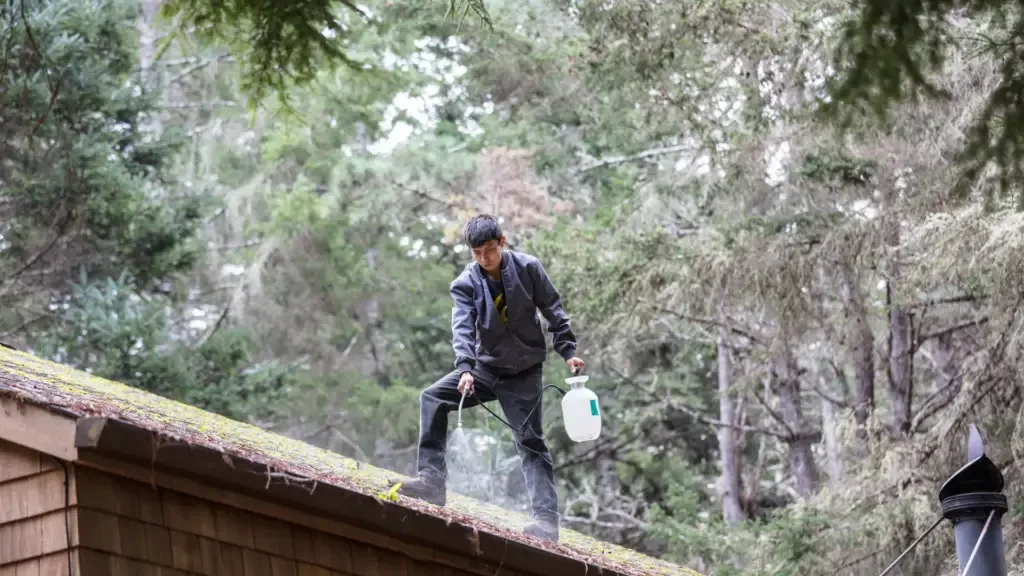
Soft Wash Roof Cleaning for Different Roof Types
Soft wash roof cleaning is a safe and effective way to clean your roof without causing any damage to it. However, different roof types require different cleaning methods. Here’s what you need to know about soft wash roof cleaning for different roof types:
Asphalt Shingle Roofs
Asphalt shingle roofs are the most common type of roof in the United States. They are made of a fiberglass mat covered in asphalt and granules.
Soft wash roof cleaning is an excellent way to clean asphalt shingle roofs. However, it’s important to use the right cleaning solution and technique to avoid damaging the shingles.
Tile Roofs
Tile roofs are popular in the southern United States and are made of clay or concrete. Soft wash roof cleaning is an effective way to clean tile roofs, but it’s essential to use the right cleaning solution.
Using the wrong cleaning solution can damage the tiles and cause them to break or crack.
Metal Roofs
Metal roofs are becoming increasingly popular in the United States due to their durability and energy efficiency. Soft wash roof cleaning is an excellent way to clean metal roofs, but it’s important to use the right cleaning solution and technique.
Using the wrong cleaning solution can damage the metal and cause it to rust.
Clay and Concrete Tile Roofs
Clay and concrete tile roofs are popular in the western United States and are known for their durability and aesthetic appeal. Soft wash roof cleaning is an effective way to clean clay and concrete tile roofs, but it’s important to use the right cleaning solution and technique.
Using the wrong cleaning solution can damage the tiles and cause them to break or crack.
Tar and Gravel Roofs
Tar and gravel roofs are common on commercial buildings and are made of multiple layers of tar and roofing felt, topped with gravel.
Soft wash roof cleaning is an excellent way to clean tar and gravel roofs, but it’s important to use the right cleaning solution and technique. Using the wrong cleaning solution can damage the tar and cause it to break down.
Slate Roofs
Slate roofs are popular on historic homes and are known for their durability and aesthetic appeal. Soft wash roof cleaning is an effective way to clean slate roofs, but it’s important to use the right cleaning solution and technique.
Using the wrong cleaning solution can damage the slate and cause it to break or crack.
In summary, soft wash roof cleaning is an excellent way to clean your roof without causing any damage. However, it’s important to use the right cleaning solution and technique for your specific roof type to avoid damaging it.

Factors Affecting Soft Wash Roof Cleaning Costs
Soft wash roof cleaning is an effective and safe way to clean your roof and improve its appearance. However, the cost of soft wash roof cleaning can vary depending on several factors. Here are some of the factors that can affect the cost of soft wash roof cleaning:
Roof Size
The size of your roof is one of the most significant factors that can affect the cost of soft wash roof cleaning. The larger the roof, the more time and cleaning solution is required, which can increase the cost.
Soft wash roof cleaning costs typically range from $0.20 to $0.60 per square foot.
Roof Type
The type of roof you have can also affect the cost of soft wash roof cleaning. Roofs made of different materials require different cleaning solutions and techniques, which can affect the cost. For example, cleaning a metal roof may require a different cleaning solution than cleaning a shingle roof.
Number of Stories
The number of stories your home has can also affect the cost of soft wash roof cleaning. If you have a multi-level roof, it may be more challenging and time-consuming to clean, which can increase the cost.
Location
The location of your home can also affect the cost of soft wash roof cleaning. If you live in an area with a high cost of living, the cost of soft wash roof cleaning may be higher. Additionally, if your home is located in a remote area, the cost may be higher due to travel expenses.
Gutter Cleaning
If your gutters are clogged or dirty, it may be necessary to clean them before soft washing your roof. Gutter cleaning can add to the cost of soft wash roof cleaning.
Moss Removal and Prevention
If your roof has moss or other growth, it may be necessary to remove it before soft washing your roof. Additionally, applying a moss prevention treatment can help prevent future growth. These services can add to the cost of soft wash roof cleaning.
Roof Repairs
If your roof has damage or needs repairs, it may be necessary to address these issues before soft washing your roof. Roof repairs can add to the cost of soft wash roof cleaning.
In summary, the cost of soft wash roof cleaning can vary depending on several factors, including roof size, roof type, number of stories, location, gutter cleaning, moss removal and prevention, and roof repairs.
It’s essential to consider these factors when estimating the cost of soft wash roof cleaning for your home.
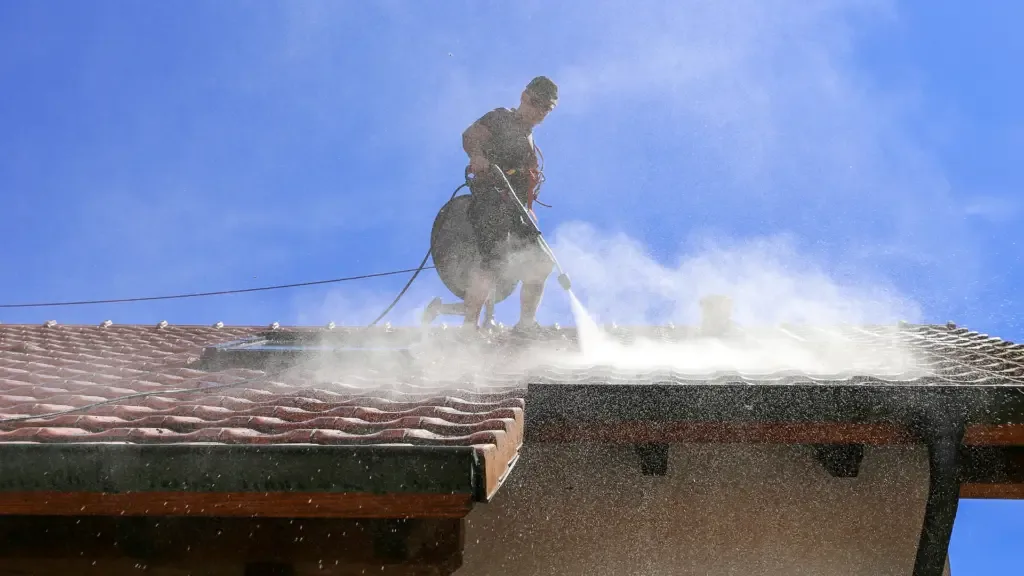
Hiring Soft Wash Roof Cleaning Professionals
If you’re not comfortable cleaning your roof yourself, it’s best to hire professionals. Here are some things to consider when hiring a soft wash roof cleaning company.
Choosing the Right Company
Choosing the right company is important to ensure that the job is done safely and efficiently. Here are some things to look for:
- Experience: Look for a company that has experience in soft wash roof cleaning. Ask how many years they have been in business and how many roofs they have cleaned.
- Insurance: Make sure the company has liability insurance and worker’s compensation insurance. This will protect you in case of any accidents or damage to your property.
- Reputation: Check online reviews and ask for references. A reputable company will have positive reviews and happy customers.
- Pricing: Get quotes from several companies and compare them. Be wary of companies that offer significantly lower prices than others.
Questions to Ask
Before hiring a company, ask them these questions:
- What is your soft wash roof cleaning process?
- What chemicals do you use?
- How long will the job take?
- Do you have insurance?
- Do you have references?
- What is your pricing?
What to Expect
When the professionals arrive, they will first assess the condition of your roof and determine the best course of action. They will then prepare the area by covering plants and furniture to protect them from the chemicals.
The cleaning process will involve spraying a cleaning solution onto the roof and letting it sit for a certain amount of time. The solution will then be rinsed off with water. The professionals will also clean the gutters and downspouts.
Hiring professionals for soft wash roof cleaning can save you time and effort. Just make sure to choose a reputable company and ask the right questions to ensure that the job is done safely and efficiently.

